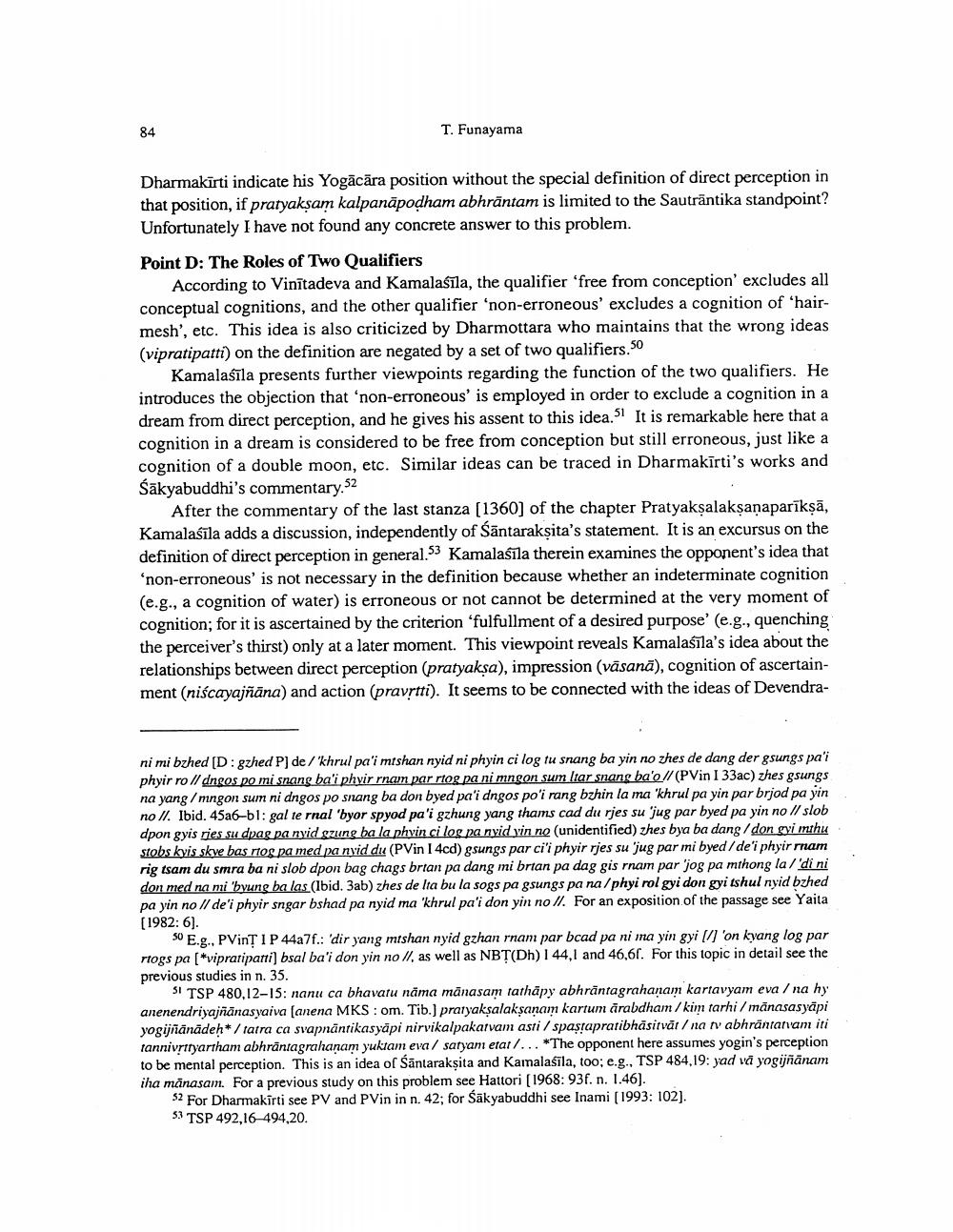________________
84
T. Funayama
Dharmakīrti indicate his Yogācāra position without the special definition of direct perception in that position, if pratyakşam kalpanāpodham abhrāntam is limited to the Sautrāntika standpoint? Unfortunately I have not found any concrete answer to this problem. Point D: The Roles of Two Qualifiers
According to Vinītadeva and Kamalasīla, the qualifier 'free from conception' excludes all conceptual cognitions, and the other qualifier 'non-erroneous' excludes a cognition of 'hairmesh', etc. This idea is also criticized by Dharmottara who maintains that the wrong ideas (vipratipatti) on the definition are negated by a set of two qualifiers.50
Kamalasīla presents further viewpoints regarding the function of the two qualifiers. He introduces the objection that 'non-erroneous' is employed in order to exclude a cognition in a dream from direct perception, and he gives his assent to this idea.51 It is remarkable here that a cognition in a dream is considered to be free from conception but still erroneous, just like a cognition of a double moon, etc. Similar ideas can be traced in Dharmakīrti's works and Sākyabuddhi's commentary.52
After the commentary of the last stanza (1360) of the chapter Pratyaksalaksanaparīksā, Kamalasīla adds a discussion, independently of Santarakṣita's statement. It is an excursus on the definition of direct perception in general. Kamalasila therein examines the opponent's idea that ‘non-erroneous' is not necessary in the definition because whether an indeterminate cognition (e.g., a cognition of water) is erroneous or not cannot be determined at the very moment of cognition; for it is ascertained by the criterion 'fulfullment of a desired purpose' (e.g., quenching the perceiver's thirst) only at a later moment. This viewpoint reveals Kamalaśīla's idea about the relationships between direct perception (pratyaksa), impression (vāsanā), cognition of ascertainment (niscayajñāna) and action (pravstti). It seems to be connected with the ideas of Devendra
ni mi bzhed (D:gzhed PJ de / 'khrul pa'i mtshan nyid ni phyin ci log tu snang ba yin no zhes de dang der gsungs pa'i phyir ro Il dngos po mi snang ba'i phyir rnam par rtog pa ni mngon sum ltar snang ba'o // (PVin 1 33ac) zhes gsungs na yang /mngon sum ni dngos po snang ba don byed pa'i dngos po'i rang bzhin la ma 'khrul pa yin par brjod pa yin no Il. Ibid. 45a6-b1: gal te rnal 'byor spyod pa'i gzhung yang thams cad du rjes su "jug par byed pa yin no ll slob dpon gyis ries su dpag pa nvid szung ba la phvin ci log pa nvid vin no (unidentified) zhes bya ba dang/don gyi mthu stobs kyis skye bas rios pa med pa nvid du (PVin 1 4cd) gsungs par ci'i phyir rjes su 'jug par mi byed / de'i phyir mam rig tsam du smra ba ni slob dpon bag chags brtan pa dang mi brtan pa dag gis rnam par 'jog pa mthong la/ 'di ni don med na mi 'byung ba las (Ibid. 3ab) zhes de la bu la sogs pa gsungs pa na/phyi rol gyi don gyi tshul nyid bzhed pa yin no II de'i phyir sngar bshad pa nyid ma 'khrul pa'i don yin no ll. For an exposition of the passage see Yaita (1982: 6).
50 E.g., PVinȚI P 44a7f.: 'dir yang mtshan nyid gzhan rnam par bcad pa ni ma yin gyi l'on kyang log par rtogs pa (*vipratipatti) bsal ba'i don yin no II, as well as NBT(Dh) 1 44,1 and 46,6f. For this topic in detail see the previous studies in n. 35.
SI TSP 480,12-15: nanu ca bhavatu nama mānasam tathāpy abhräntagrahanam kartavyam eva / na hy anenendriyajñānasyaiva (anena MKS: om. Tib.) pratyaksalaksanam kartum árabdham/kim tarhi/mānasasyäpi yogijñānādeh* / tatra ca svapnänrikasyāpi nirvikalpakarvam asti / spastapratibhasitvāt / na tv abhräntanam iti tannivrityartham abhrāntagrahanam yuktam eva/satyan etat /... *The opponent here assumes yogin's perception to be mental perception. This is an idea of śāntarakṣita and Kamalasīla, too; e.g., TSP 484,19: yad va yogijñānam iha mănasam. For a previous study on this problem see Hattori (1968: 93f. n. 1.46).
52 For Dharmakirti see PV and PVin in n. 42; for sākyabuddhi see Inami (1993: 102). 53 TSP 492,16-494,20.




